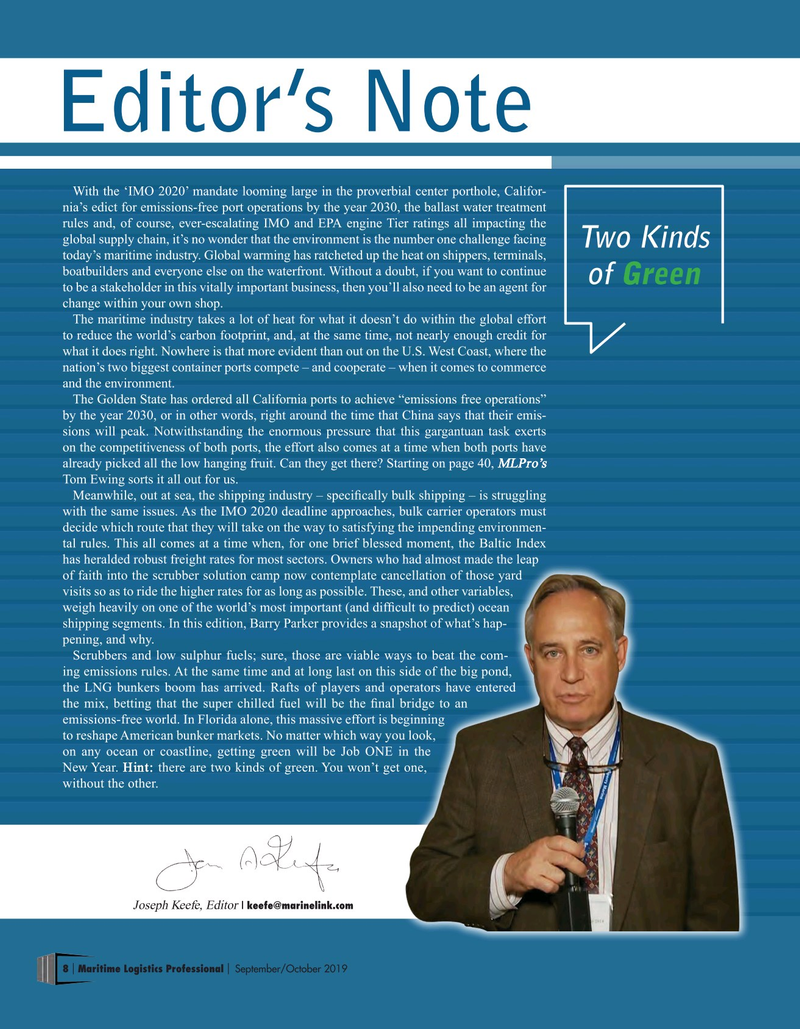
Page 8: of Maritime Logistics Professional Magazine (Sep/Oct 2019)
Energy Ports Oil-Gas-LNG
Read this page in Pdf, Flash or Html5 edition of Sep/Oct 2019 Maritime Logistics Professional Magazine
Editor’s Note
With the ‘IMO 2020’ mandate looming large in the proverbial center porthole, Califor- nia’s edict for emissions-free port operations by the year 2030, the ballast water treatment rules and, of course, ever-escalating IMO and EPA engine Tier ratings all impacting the global supply chain, it’s no wonder that the environment is the number one challenge facing
Two Kinds today’s maritime industry. Global warming has ratcheted up the heat on shippers, terminals, boatbuilders and everyone else on the waterfront. Without a doubt, if you want to continue of Green to be a stakeholder in this vitally important business, then you’ll also need to be an agent for change within your own shop.
The maritime industry takes a lot of heat for what it doesn’t do within the global effort to reduce the world’s carbon footprint, and, at the same time, not nearly enough credit for what it does right. Nowhere is that more evident than out on the U.S. West Coast, where the nation’s two biggest container ports compete – and cooperate – when it comes to commerce and the environment.
The Golden State has ordered all California ports to achieve “emissions free operations” by the year 2030, or in other words, right around the time that China says that their emis- sions will peak. Notwithstanding the enormous pressure that this gargantuan task exerts on the competitiveness of both ports, the effort also comes at a time when both ports have already picked all the low hanging fruit. Can they get there? Starting on page 40, MLPro’s
Tom Ewing sorts it all out for us.
Meanwhile, out at sea, the shipping industry – specifcally bulk shipping – is struggling with the same issues. As the IMO 2020 deadline approaches, bulk carrier operators must decide which route that they will take on the way to satisfying the impending environmen- tal rules. This all comes at a time when, for one brief blessed moment, the Baltic Index has heralded robust freight rates for most sectors. Owners who had almost made the leap of faith into the scrubber solution camp now contemplate cancellation of those yard visits so as to ride the higher rates for as long as possible. These, and other variables, weigh heavily on one of the world’s most important (and diffcult to predict) ocean shipping segments. In this edition, Barry Parker provides a snapshot of what’s hap- pening, and why.
Scrubbers and low sulphur fuels; sure, those are viable ways to beat the com- ing emissions rules. At the same time and at long last on this side of the big pond, the LNG bunkers boom has arrived. Rafts of players and operators have entered the mix, betting that the super chilled fuel will be the fnal bridge to an emissions-free world. In Florida alone, this massive effort is beginning to reshape American bunker markets. No matter which way you look, on any ocean or coastline, getting green will be Job ONE in the
New Year. Hint: there are two kinds of green. You won’t get one, without the other.
Joseph Keefe, Editor | [email protected] 8 Maritime Logistics Professional September/October 2019 | |

 7
7

 9
9
